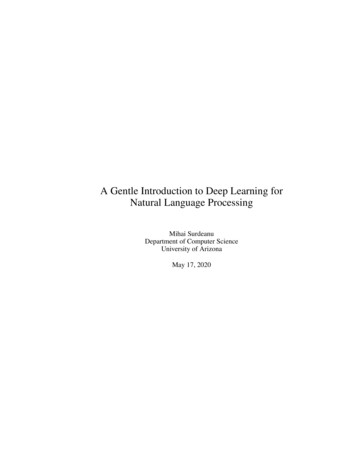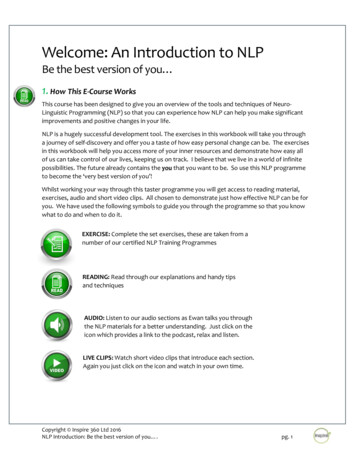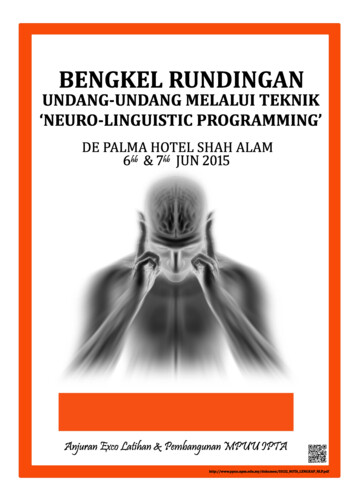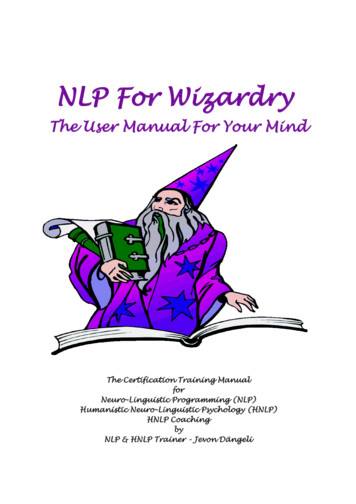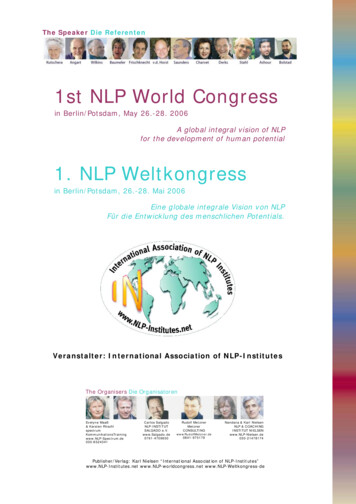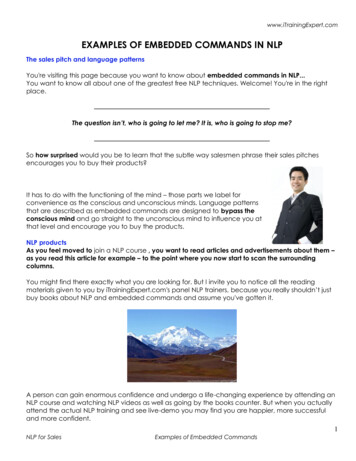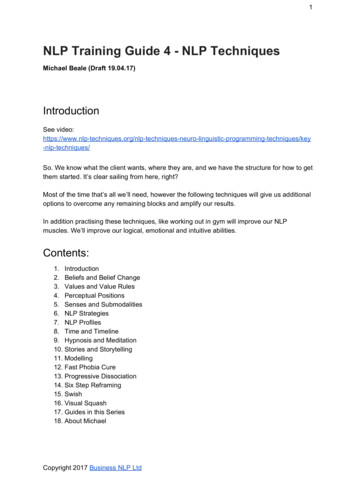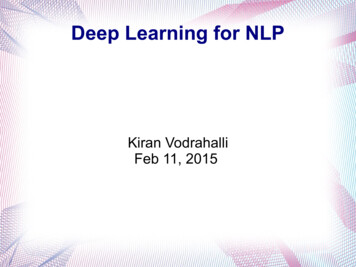
Transcription
Deep Learning for NLPKiran VodrahalliFeb 11, 2015
Overview What is NLP?–Natural Language Processing–We try to extract meaning from text: sentiment,word sense, semantic similarity, etc.How does Deep Learning relate?– NLP typically has sequential learning tasksWhat tasks are popular?–Predict next word given context–Word similarity, word disambiguation–Analogy / Question answering
Papers Timeline Bengio (2003) Hinton (2009) Mikolov (2010, 2013, 2013, 2014)– RNN word vector phrase vector paragraph vectorQuoc Le (2014, 2014, 2014)Interesting to see the transition of ideas andapproaches (note: Socher 2010 – 2014 papers)We will go through the main ideas first andassess specific methods and results in more
Standard NLP Techniques Bag-of-Words Word-Context Matrices –LSA–Others. (construct matrix, smooth, dimensionreduction)Topic modeling–Latent Dirichlet Allocation N-gramsStatistics-based
Some common metrics in NLP Perplexity (PPL): Exponential of average negative log likelihood–geometric average of the inverse of probability of seeing a wordgiven the previous n words2 to the power of cross entropy of your language model with thetest data1– ̂t 1P (w t w 1 )BLEU score: measures how many words overlap in a given translationcompared to a reference, with higher scores given to sequential words– – Values closer to 1 are more similar (would like human and machinetranslation to be very close)Word Error Rate (WER): derived from Levenstein distance–WER (S D I)/ (S D C)–S substitutions, D deletions, I insertions, C corrections
Statistical Model of Language Conditional probability of one word given all theprevious ones
Issues for Current Methods Too slowStopped improving when fed increasingly largeramounts of dataVery simple and naïve; works surprisingly wellbut not well enoughVarious methods don't take into accountsemantics, word-order, long-range contextA lot of parsing required and/or hand-builtmodelsNeed to generalize!
N-grams Consider combinations of successive words ofsmaller size and predict see what comes nextfor all of those.Smoothing can be done for new combinations(which do not occur in training set)Bengio: we can improve upon this!–They don't typically look at contexts 3 words–Words can be similar: n-grams don't use this togeneralize when we should be!
Word Vectors Concept will show up in a lot of the papersThe idea is we represent a word by a densevector in semantic spaceOther vectors close by should be semanticallysimilarSeveral ways of generating them; the paperswe will look at generate them with Neural Netprocedures
Neural Probabilistic LanguageModel (Bengio 2003) Fight the curse of dimensionality withcontinuous word vectors and probabilitydistributionsFeedforward net that both learns word vectorrepresentation and a statistical language modelsimultaneouslyGeneralization: “similar” words have similar featurevectors; probability function is smooth function of thesevalues small change in features induces small changein probability, and we distribute the probability massevenly to a combinatorial number of similar neighboringsentences every time we see a sentence.
Bengio's Neural Net Architecture
Bengio Network Performance Has lower perplexity than smoothed tri-grammodels (weighted sum of probabilities ofunigram, bigram, up to trigram) on BrowncorpusPerplexity of best neural net approach: 252– (100 hidden units; look back 4 words; 30 wordfeatures, no connections between word layerand output layer; output probability averagedwith trigram output probability)Perplexity of best tri-gram only approach: 312
RNN-based Language Model(Mikolov 2010) RNN-LM: 50% reduction on perplexity possibleover n-gram techniquesFeeding off of Bengio's work, which usedfeedforward net Now we try RNN! Moregeneral, not as dependent on parsing,morphology, etc. Learn from the data directly.Why use RNN?–Language data is sequential; RNN is goodapproach for sequential data (no requiredfixed input size) can unrestrict context
Simple RNN Model
RNN Model Description Input: x(t): formed by concatenating vector w (currentword) with the context s(t – 1)Hidden context layer activation: sigmoidOutput y(t): softmax layer to output probabilitydistribution (we are predicting probability of each wordbeing the next word)error(t) desired(t) – y(t); where desired(t) is 1-of-Vencoding for the correct next word Word input uses 1-of-V encoding Context layer can be initialized with small weights Use trunctated backprop through time (BPTT) and
More details on RNN model Rare word tokens: merge words that occur lessoften than some threshold into a rare-wordtoken–– prob(rare word) yrare(t)/ (number of rare words)yrare(t) is the rare-word tokenThe dynamic model: network should continuetraining even during testing phase, since thepoint of the model is to update the context
Performance of RNN vs. KN5 onWSJ dataset
More data larger improvement
More RNN comparisons Previous approaches were not state-of-theart,we display improvement on state-of-the-artAMI system for speech transcription inmeetings on NIST RT05 datasetTraining data: 115 hours of meeting speechfrom many training corpora
Mikolov 2013 Summary In 2013, word2vec (Google) made big newswith word vector representations that were ableto represent vector compositionalityvec(Paris) – vec(France) vec(Italy) vec(Rome)Trained relatively quickly, NOT using neural netnonlinear complexity“less than a day to learn high quality word vectorsfrom 1.6 billion word Google News corpus dataset”(note: this corpus internal to Google)
Efficient Estimation of Word Representationsin Vector Space (Mikolov 2013) Trying to maximize accuracy of vectoroperations by developing new modelarchitectures that preserve linear regularitiesamong words; minimize complexityApproach: continuous word vectors learnedusing simple model; n-gram NNLM (Bengio)trained on top of these distributedrepresentationsExtension of previous two papers (Bengio;Mikolov(2010) )
Training Complexity We are concerned with making the complexity as simpleas possible to allow training on larger datasets in smalleramounts of time.Definition: O E*T*Q, where E # of training epochs, T # of words in training set, Q model-specific factor (i.e. ina neural net, counting number of size of connectionmatrices)N: # previous words, D: # dims in representation, H:hidden layer size; V: vocab size Feedforward NNLM: Q N*D N*D*H H*log2V Recurrent NNLM (RNNLM): Q H*H H*log2V–Log2V comes from using hierarchical softmax
Hierarchical Softmaxe zjK ezi 1Want to learn probability distribution on wordskSpeed up calculations by building aconditioning treeTree is Huffman code: high-frequency wordsare assigned small codes (near the top of thetree)Improves updates from V to log2V
New Log-linear models CBOW (Continuous Bag of Words)–Context predicts word–All words get projected to same position (averaged) loseorder of words info–Q N*D D*log2VSkip-gram (we will go into more detail later)–Word predicts context, a range before and after the current word–Less weight given to more distant words–Log-linear classifier with continuous projection layer–C: maximum distance between words–Q C*( D D*log2V)avoid the complexity of neural nets to train good word vectors; use log-linearoptimization (achieve global maximum on max log probability objective)Can take advantage of more data due to speed up
CBOW Diagram
Skip-gram diagram
Results Vector algebra result: possible to find answersto analogy questions like “What is the word thatis similar to small in the same sense as biggestis to big?” (vec(“biggest”) - vec(“big”) vec(“small”) ?)The task: test set containing 5 types ofsemantic questions; 9 types of syntacticquestionsSummarized in the following table:
Mikolov test questions
Performance on SyntacticSemantic Questions
Summary comparison of architectures Word vectors from RNN perform well onsyntactic questions; NNLM vectors performbetter than RNN (RNNLM has a non-linearlayer directly connected to word vectors; NNLMhas interfering projection layer) CBOW NNLM on synactic, bit better on semantic Skip-gram CBOW (a bit worse) on syntactic Skip-gram everything else on semantic This is all for training done with parallel training
Comparison to other approaches(1 CPU only)
Varying epochs, training set size
Microsoft Sentence Completion 1040 sentences; one word missing / sentence,goal is to select the word that is most coherentwith the rest of the sentence
Skip-gram Learned Relationships
Versatility of vectors Word vector representation also allows solvingtasks like finding the word that doesn't belong inthe list (i.e. (“apple”, “orange”, “banana”,“airplane”) )Compute average vector of words, find themost distant one this is out of the list.Good word vectors could be useful in manyNLP applications: sentiment analysis,paraphrase detection
DistBelief Training They claim should be possible to train CBOWand Skip-gram models on corpora with 10 12words, orders of magnitude larger than previousresults (log complexity of vocabulary size)
Focusing on Skip-gram Skip-gram did much better than everything elseon the semantic questions; this is interesting.We investigate further improvements (Mikolov2013, part 2)Subsampling gives more speedupSo does negative sampling (used overhierarchical softmax)
Recall: Skip-gram Objective
Basic Skip-gram Formulation (Again, we're maximizing average logprobability over the set of context words wepredict with the current word)C is the size of the training context– Larger c more accuracy, more timev w and v w' are input and outputrepresentations of w, W is # of wordsUse softmax function to define probability; thisformulation is not efficient hierarchicalsoftmax
OR: Negative Sampling Another approach to learning good vectorrepresentations to hierarchical softmaxBased off of Noise Constrastive Estimation(NCE): a good model should differentiate datafrom noise via logistic regressionSimplify NCE Negative sampling
Explanation of NEG objective For each (word, context) example in the corpus wetake k additional samples of (word, context) pairs NOTin the corpus (by generating random pairs according tosome distribution Pn(w))We want the probability that these are valid to be verylowThese are the “negative samples”; k 5 – 20 for largerdata sets, 2 – 5 for small
Subsampling frequent words Extremely frequent words provide lessinformation value than rarer wordsEach word w i in training set is discarded withprobability; t (threshold) 10 -5: aggressivelysubsamples while preserving frequency rankingAccelerates learning; does well in practicef is frequency of word; P(w i): prob to discard
Results on analogical reasoning(previous paper's task) Recall the task: “Germany”: “Berlin” :: “France”:?Approach to solve: find x s.t. vec(x) is closest tovec(“Berlin”) - vec(“Germany”) vec(“France”)V 692KStandard sigmoidal RNNs (highly non-linear)improve upon this task; skip-gram is highlylinearSigmoidal RNNs preference for linearstructure? Skip-gram may be a shortcut
Performance on task
What do the vectors look like?
Applying Approach to Phrasevectors “phrase” meaning can't be found by composition; wordsthat appear frequently together; infrequently elsewhereEx: New York Times becomes a single tokenGenerate many “reasonable phrases” usingunigram/bigram frequencies with a discount term; (don'tjust use all n-grams)Use Skip-gram for analogical reasoning task for phrases (3128examples)
Examples of analogical reasoningtask for phrases
Additive Compositionality Can meaningfully combine vectors with termwise additionExamples:
Additive Compositionality Explanation: word vectors in linear relationshipwith softmax nonlinearityVectors represent distribution of context inwhich word appearsThese values are logarithmically related toprobabilities, so sums correspond to products;i.e. we are ANDing together the two words inthe sum.Sum of word vecs product of contextdistributions
Nearest Neighbors of InfrequentWords
Paragraph Vector! Quoc Le and Mikolov (2014) Input is often required to be fixed-length for NNs Bag-of-words lose ordering of words and ignore semantics Paragraph Vector is unsupervised algorithm that learnsfixed length representation of from variable-length texts:each doc is a dense vector trained to predict words in thedocMore general than Socher approach (RNTNs)New state-of-art: on sentiment analysis task, beat the bestby 16% in terms of error rate.Text classification: beat bag-of-words models by 30%
The model Concatenate paragraph vector with severalword vectors (from paragraph) predictfollowing word in the contextParagraph vectors and word vectors trained bySGD and backprop Paragraph vector unique to each paragraph Word vectors shared over all paragraphs Can construct representations of variablelength input sequences (beyond sentence)
Paragraph Vector Framework
PV-DM: Distributed MemoryModel of Paragraph Vectors N paragraphs, M words in vocab Each paragraph p dims; words q dims N*p M*q; updates during training are sparse Contexts are fixed length, sliding window overparagraph; paragraph shared across allcontexts which are derived from that paragraphParagraph matrix D; tokens act as memory“what is missing” from current contextParagraph vector averaged/concatenated withword vectors to predict next word in context
Model parameters recap Word vectors W; softmax weights U, bParagraph vectors D on previously seenparagraphsNote: at prediction time, need to calculateparagraph vector for new paragraph. dogradient descent leaving all other parameters(W, U, b) fixed.Resulting vectors can be fed to other MLmodels
Why are paragraph vectors good Learned from unlabeled dataTake word order into consideration (better thann-gram)Not too high-dimensional; generalizes well
Distributed bag of words Paragraph vector w/out word orderStore only softmax weights aside fromparagraph vectorsForce model to predict words randomlysampled from paragraph(sample text window, sample word from windowand form classification task with vector)Analagous to skip-gram model
PV-DBOW picture
Experiments Test with standard PV-DM Use combination of PV-DM with PV-DBOW Latter typically does better Tasks:–Sentiment Analysis (Stanford Treebank)–Sentiment Analysis (IMDB)–Information Retrieval: for search queries, createtriple of paragraphs. Two are from queryresults, one is sampled from rest of collection Which is different?
Experimental Protocols Learned vectors have 400 dimensionsFor Stanford Treebank, optimal window size 8: paragraph vec 7 word vecs predict 8thword For IMDB, optimal window size 10 Cross validate window size between 5 and 12 Special characters treated as normal words
Stanford Treebank Results
IMDB Results
Information Retrieval Results
Takeaways of Paragraph Vector PV-DM PV-DBOW; combination is best Concatenation sum in PV-DM Paragraph vector computation can beexpensive, but is do-able. For testing, the IMDBdataset (25,000 docs, 230 words/doc)For IMDB testing, paragraph vectors werecomputed in parallel 30 min using 16 coremachineThis method can be applied to other sequentialdata too
Neural Nets for MachineTranslation Machine translation problem: you have asource sentence in language A and a targetlanguage B to deriveTranslate A B: hard, large # of possibletranslationsTypically there is a pipeline of techniquesNeural nets have been considered ascomponent of pipeline Lately, go for broke: why not do it all with NN? Potential weakness: fixed, small vocab
Sequence-to-Sequence Learning(Sutskever, Vinyals, Le 2014) Main problem with deep neural nets: can onlybe applied to problems with inputs and targetsof fixed dimensionalityRNNs do not have that constraint, but havefuzzy memoryLSTM is a model that is able to keep long-termcontextLSTMs are applied to English to Frenchtranslation (sequence of english words sequence of french words)
How are LSTMs Built?(references to Graves (2014))
Basic RNN: “Deep learning intime and space”
LSTM Memory Cells Instead of hidden layer being element-wiseapplication of sigmoid function, we customdesign “memory cells” to store informationThese end up being better at finding / exploitinglong-range dependencies in data
LSTM block
LSTM equationsi t: input gate, f t: forget gate, c t: cell, o t: output gat,h t: hidden vector
Model in more detail Deep LSTM1 maps input sequence to largefixed-dimension vector; reads input 1 time stepat a timeDeep LSTM2: decodes target sequence fromfixed-dimension vector (essentially RNN-LMconditioned on input sequence)Goal of LSTM: estimate conditional probabilityp(yT' xT), where xT is the sequence of englishwords (length T) and yT' is a translation tofrench (length T'). Note T ! T' necessarily.
LSTM translation overview
Model continued (2) Probability distributions represented withsoftmax. v is fixed dimensional representation of inputxT
Model continued (3) Different LSTMs were used for input and output(trained with different resulting weights) cantrain multiple language pairs as a resultLSTMs had 4 layersIn training, reversed the order of the inputphrase (the english phrase).If a, b, c corresponds to x, y, z , then theinput was fed to LSTM as: c, b, a x, y, z This greatly improves performance
Experiment Details WMT '14 English-French dataset: 348M FrenchWords, 304M English wordsFixed vocabulary for both languages:–160000 english words, 80000 french words–Out of vocab: replaced with unk Objective: maximize log probability of correcttranslation T given source sentence SProduce translations by finding the most likelyone according to LSTM using beam-searchdecoder (B partial hypotheses at any giventime)
Training Details Deep LSTMs with 4 layers; 1000 cells/layer;1000-dim word embeddingsUse 8000 real #s to represent sentence– (4*1000) *2Use naïve softmax for output384M parameters; 64M are pure recurrentconnections (32M for encoder and 32M fordecoder)
Experiment 2 Second task: Took an SMT system's 1000-bestoutputs and re-ranked them with the LSTMCompute log probability of each hypothesis andaverage previous score with LSTM score; reorder.
More training details Parameter init uniform between -0.08 and 0.08Stochastic gradient descent w/out momentum(fixed learning rate of 0.7)Halved learning rate each half-epoch after 5training epochs; 7.5 total epochs for training128-sized batches for gradient descentHard constraint on norm of gradient to preventexplosionEnsemble: random initializations randommini-batch order differentiate the nets
BLEU score: reminder Between 0 and 1 (or 0 and 100 multiply by100)Closer to 1 means better translationBasic idea: given candidate translation, get thecounts for each of the 4-grams in the translationFind max # of times each 4-gram appears inany of the reference translations, and calculatethe fraction for 4-gram x: (#x in candidatetranslation)/(max#x in any reference translation)Take geometric mean to obtain total score
Results (BLEU score)
Results (PCA projection)
Performance v. length; rarity
Results Summary LSTM did well on long sentencesDid not beat the very best WMT'14 system, firsttime that pure neural translation outperforms anSMT baseline on a large-scale task by a widemargin, even though the LSTM model does nothandle out-of-vocab termsImprovement by reversing the word order–Couldn't train RNN model on non-reversedproblem–Perhaps is possible with reversed modelShort-term dependencies important for learning
Rare Word Problem In the Neural Machine Translation system wejust saw, we had a small vocabulary (only 80k)How to handle out-of-vocab (OOV) words?Same authors a few others from previouspaper decided to upgrade their previous paperwith a simple word alignment techniqueMatches OOV words in target to correspondingword in source, and does a lookup usingdictionary
Rare Word Problem (2) Previous paper observes sentences with manyrare words are translated much more poorlythan sentences containing mainly frequentwords(contrast with Paragraph vector, where lessfrequent vectors added more information recall paragraph vector was unsupervised)Potential reason prev paper didn't beatstandard MT systems: did not take advantageof larger vocabulary and explicit alignments/phrase counts fail on rare words
How to solve rare word for NMT? Previous paper: use unk symbol to representall OOV words
How to solve – intelligently! Main idea: match the unk outputs with theword that caused them in the source sentenceNow we can do a dictionary lookup andtranslate the source wordIf that fails, we can use identity map just stickthe word in from source language (might be thesame in both languages typically forsomething like a proper noun)
Construct Dictionary First we need to align the parallel texts–Do this with an unsupervised aligner (Berkeleyaligner, GIZA tools exist.)–General idea: can use expectation maximizationon parallel corpora–Learn statistical models of the language, findsimilar features in the corpora and align them–A field unto itselfWe DO NOT use the neural net to do anyaligning!
Constructing Dictionary (2) Three strategies for annotating the textswe're modifying the text based on alignmentunderstandingThey are:–Copyable Model–PosAll Model (Positional All)–PosUnk Model (Positional Unknown)
Copyable Model Order unknown words unk1,. in source For unknown – unknown matches, use unk1, 2, etc. For unknown – known matches, use unk null (cannottranslate unk null)Also use null when no alignment
PosAll Model Only use unk tokenIn target sentence, place a pos d token beforeevery unk pos d denotes relative position that the targetword is aligned to in source ( d 7)
PosUnk Model Previous model doubles length of targetsentence.Let's only annotate alignments of unknownwords in targetUse unkpos d ( d 7): denote unknown andrelative distance to aligned source word (d setto null when no alignment)Use unk for all other source unknowns
PosUnk Model
Training Train on same dataset as previous paper for comparisonwith same NN model (LSTM)They have difficult with softmax slowness on vocabulary,so they limit to 40K most used french words (reduced from80k) (only on the output end)(they could have used hierarchical softmax or Negativesampling) On source side, they use 200K most frequent words ALL OTHER WORDS ARE UNKNOWN They used the previously-mentioned Berkeley aligner indefault
Results
Results (2) Interesting to note that ensemble models getmore gain from the post-processing stepMore larger models identify source wordposition more accurately PosUnk moreusefulBest result outperforms currently existing stateof-the-artWay outperforms previous NMT systems
And now for somethingcompletely different. Semantic Hashing – Salakhutdinov & Hinton(2007) Finding binary codes for fast document retrieval Learn a deep generative model: –Lowest layer is word-count vector–Highest is a learned binary code for documentUse autoencoders
TF-IDF Term frequency-inverse document frequencyMeasures similarity between documents bycomparing word-count vectors freq(word in query) log(1/freq(word in docs)) Used to retrieve documents similar to a querydocument
Drawbacks of TF-IDF Can be slow for large vocabulariesAssumes counts of different words areindependent evidence of similarityDoes not use semantic similarity betweenwordsOther things tried: LSA, pLSA, LDAWe can view as follows: hidden topic variableshave directed connections to word-countvariables
Semantic hashing Produces shortlist of documents in timeindependent of the size of the documentcollection; linear in size of shortlistThe main idea is that learned binary projectionsare a powerful way to index large collectionsaccording to contentFormulate projections to preserve a similarityfunction of interestThen can explore Hamming ball volume arounda query, or use hash tables to search data(radius d: differs in at most d positions)
Semantic Hashing (cont.) Why binary? By carefully choosing informationfor each bit, can do better than real-valuesOutline of approach:–Generative model for word-count vectors–Train RBMs recursively based on generativemodel–Fine-tune representation with multi-layerautoencoder–Binarize output of autoencoder withdeterministic Gaussian noise
The Approach
Modeling word-count vectors Constrained Poisson for modeling word countvectors v–Ensure mean Poisson rates across all wordssum to length of document–Learning is stable; deals appropriately w/difflength documentsConditional Bernoulli for modeling hidden topicfeatures
First Layer: Poisson Binary
Model equations
Marginal distribution p(v) w/energy
Gradient AscentUpdates/approximation
Pre-training: Extend beyond onelayer Now we have the first layer, from Poisson wordcount vector to first binary layer.Note that this defines an undirected model p(v,h)The next layers will all be binary binaryp(v) (higher level RBM) starts out as p(h) fromlower level, train using data generated from p(h v) applied to the training data.By some variational bound math, thisconsistently increases lower bound on logprobability (which is good)
Summary so far Pre-training: We're using higher-level RBMs toimprove our deep hierarchical model Higher level RBMs are binary binary First level is Poisson binary The point of all this is to initialize weights in theautoencoder to learn a 32-dim representationThe idea is that this pretraining finds a goodarea of parameter space (based on the ideathat we have a nice generative model)
The Autoencoder Autoencoder teaches an algorithm to learn anidentity function with reduced dimensionalityThink of it as forcing the neural net toencapsulate as much information as possible inthe smaller # of dimensions so that it canreconstruct it as best as it canWe use backpropagation here to train wordcount vectors with previous architecture (errordata comes from itself); divide by N to getprobability distributionUse cross-entropy error with softmax output
Binarizing the code We want the codes found by the autoencoder tobe as close to binary as possibleAdd noise: best way to communicate info inpresence of noise is to boost your signals sothat they are distinguishable i.e. one strongpositive, one strong negative signal binaryDon't want noise to mess up training, so wekeep it fixed “deterministic noise”Use N(0, 16)
Testing The task: given a query document, retrieverelevant documentsRecall # retrieved relevant docs/ total relevantdocsPrecision # relevant retrieved docs / totalretrieved docsRelevance check if the documents have thesame class labelLSA and TF-IDF are used as benchmarks
Corpora 20-Newsgroups–18845 postings from Usenet–20 different topics–Only considered 2000 most frequent words intrainingReuters Corpus Vol II–804414 newswire stories, 103 topics–Corporate/industrial, econ, gov/soc, markets–Only considered 2000 most frequent words intraining
Results (128-bit)
Precision-Recall Curves
Results (20-bit) Restricting the bit size down to only 20 bits,does it still work well? (0.4 docs / address)Given: query compute 20bit address– retrieve all documents in Hamming Ball ofradius 4 ( 2500 documents)– No search performed– short list made with TF-IDF– no precision or recall lost when TF-IDFrestricted to this pre-selected set!– considerable speed up
Results (20bit)
Some Numbers 30-bit for 1 billion docs: 1 doc/address; requiresa few Gbs of memoryHamming Ball radius 5 175000 shortlist w/nosearch (can simply enumerate when required)Scaling learning is not difficult–Training on 10 9 docs takes few weeks with100 cores–“large organization” could train on many billionsNo need to generalize to new data if learning isongoing (should improve upon results)
Potential problem Documents with similar addresses have similarcontent, but converse is not necessarily trueCould have multiple spread out regions whichare the same internally and also sameexternally, but far apart.Potential fix: add an extra penalty term duringoptimization can use information aboutrelevance of documents to construct this term can backpropagate this through the net
How to View Semantic Hashing Each of the binary values in the coderepresents a set containing about half thedocument collectionWe want to intersect these sets for particularfeaturesSemantic hashing is a way of mapping setintersections required directly onto address busAddress bus can intersect sets with a singlemachine instruction!
Overview of Deep Learning NLP Colorful variety of approachesStarted a while ago, revival of old ideas today applied to moredata and better systems Neural Net Language Model (Bengio) RNNLM (use recurrent instead of feedforward) Skip-gram (2013) (simplification good) Paragraph Vector (2014) (beats Socher) LSTMs for MT (2014) (Sequence – Sequence w/LSTM) Semantic Hashing (Autoencoders) We did not cover: Socher and RNTN for instance
Thank you for listening!
CitationsNote: some of the papers on here were used for reference and understandingpurposes – not all were presented1. Vincent, P. & Bengio, Y. A Neural Probabilistic Language Model. 3, 1137–1155 (2003).2. Mikolov, T., Karafi, M. & Cernock, J. H. A Recurrent Neural Network Based Language Model. 1045–1048 (2010).3. Luong, M.-T., Sutskever, I., Le, Q. V., Vinyals,
Overview What is NLP? - Natural Language Processing - We try to extract meaning from text: sentiment, word sense, semantic similarity, etc. How does Deep Learning relate? - NLP typically has sequential learning tasks What tasks are popular? - Predict next word given context - Word similarity, word disambiguation - Analogy / Question answering

